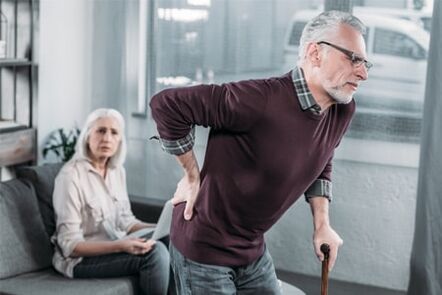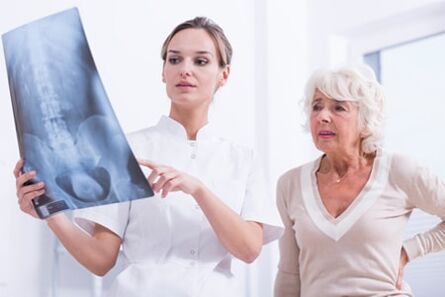
Degenerative-destructive lesion of the spine, otherwise:osteochondrosis- a disease that involves damage to a person's ligament and articular apparatus, intervertebral discs, and vertebral bodies.
Osteochondrosis disease mainly affects the elderly, regardless of gender, although it should be noted that recently there is a tendency for renewal of this disease. Such a renewal of osteochondrosis is directly related to the poor physical development of children and overweight in so many adolescents. In addition, modern youth prefer to sit in front of the TV or computer, avoiding sports. The combination of these factors leads to weakening of the back muscles, posture disorders and other negative consequences for the spine.
Osteochondrosis and its causes

At the heart of osteochondrosis disease is a disorder of vertebral and intervertebral disc trophism, which alters the normal tissue structure. As a result, the cartilage disc loses its elasticity and its normal shape, reducing the width of the spaces between the vertebrae. Violation of the intervertebral ratio leads to compression of the nerve endings of the spinal cord, as well as to a considerable overload of the spinal muscles, which explains the occurrence of pain in osteochondrosis. In addition, with osteochondrosis, quite serious complications often occur, such as swelling of a part of the intervertebral disc, as well as vertebral hernias.
In the future, the degenerative-destructive changes that occur in osteochondrosis lead to the formation of bone growths in the vertebrae, also spreading to the intervertebral ligaments and small joints of the spine. For people suffering from osteochondrosis it becomes difficult to perform flexion-extensor movements and over time they can develop pathology - scoliosis or kyphosis.
All of these degenerative-destructive spinal lesions are usually the result of the inevitable physiological aging of the human body, but for a number of reasons discussed later in this publication, the osteochondrosis process can be significantly accelerated.
It should be noted immediately that there is no single cause for the onset of osteochondrosis, but there are a large number of predisposing factors and the main ones are:
- bruising, fractures, dislocations and other spinal injuries;
- hereditary predisposition;
- various foot diseases causing vertebral overload, such as plantar fasciitis, flat feet and others, as well as prolonged wearing of uncomfortable and tight shoes;
- obesity or overweight;
- natural age-related changes in the body;
- violation of metabolic processes in the body;
- maintaining a sedentary lifestyle;
- immediate cessation of professional sports;
- specifics of professional activity, for example, frequent vibrations and twists of the body, lifting weights, uncomfortable body position during work;
- prolonged and frequent hypothermia, aggravated by high humidity;
- the presence of frequent and prolonged stressful conditions.
The presence of some or even one of the above factors can lead to the development of osteochondrosis, which is conventionally divided into four stages:
- The first phase- a decrease in the amount of moisture contained in the intervertebral disc with a decrease in intervertebral distance. In this case small cracks appear in the cartilage.
- Second phase- due to the reduction of intervertebral spaces, the ligament and muscular apparatus hang, which leads to unnatural mobility of vertebral bodies, their displacement and sliding.
- The third phase- due to the progressive degenerative-destructive lesion of the spine, there is an extrusion of the intervertebral discs, as well as vertebral subluxations.
- The fourth stage- to prevent subluxations and unnatural mobility of the vertebrae, bone osteophytes grow between the vertebrae, in popular treatment they are called "salt deposits", which over time become so numerous that the vertebrae lose their mobility. With such bone growth, injuries to nerves and vessels located near these vertebrae inevitably occur.
It should be noted that in the first and fourth stage of osteoarthritis, patients do not experience pain.
Osteochondrosis and its classification
Although osteochondrosis has many different classifications, the most common is the osteochondrosis classification, which takes into account the localization of spinal lesions:
- osteochondrosis of the cervical spine;
- osteochondrosis of the thoracic spine;
- lumbar spine osteochondrosis;
- osteochondrosis of the sacral spine;
- common osteochondrosis, which involves a disease of two or more vertebral sections.
Osteochondrosis and its symptoms
Osteochondrosis, as a disease, is chronic in nature and is characterized by the alternation of remission phase and exacerbation phase, in which the symptoms of osteochondrosis are particularly characteristic, depending on the location of the spinal disease as well as its presence. of possible complications.
So for osteochondrosis of the cervical region, pain directly in the neck, in the hands, a certain stiffness of movements, headache and numbness of the fingers will be characteristic. Well, in case of compression of the vertebral artery, the patient has a headache of pulsating nature, it is also possible a decrease in the functions of the hearing apparatus, dizziness and fainting.
Somewhat different are the symptoms of osteochondrosis of the chest region. The patient is concerned about back pain, which can also be acute, difficulty breathing with full chest, heart pain, as well as a sensation, so-called in the popular treatment - "cola in the chest".
Symptoms of osteochondrosis in case of lumbar spine injury are manifested by pain in the lower back, legs, sacrum and intensify during movement. In addition, numbness of the legs occurs and various dysfunctions of the genitourinary organs may develop.
During the remission phase, a patient may also experience pain that is not pronounced and only appears in the case of provocative factors, for example, an uncomfortable position of the patient's body.
Osteochondrosis and its diagnosis

First of all, patients should keep in mind that a neuropathologist is engaged in the treatment of osteochondrosis. The diagnosis of osteochondrosis usually involves the following steps:
- questioning the patient;
- external examination and palpation of the patient's spine in different positions of the body, as well as the establishment of a possible range of motion;
- special studies for the diagnosis of osteochondrosis through nuclear magnetic resonance, computed tomography, as well as x-ray examination of the patient;
- special studies of peripheral nerves and blood vessels, but only in cases necessary for the accurate diagnosis of osteochondrosis.
If you do not engage in timely and correct treatment of osteochondrosis, preferably without the use of folk remedies, then there is a real risk of developing various complications in the form of diseases such as, for example, sciatica, disc herniation, migraine, vegetative vascular dystonia. , and with lumbar osteochondrosis - also stroke. Therefore, proper attention should be paid to the diagnosis of osteochondrosis and its treatment, avoiding independent alternative treatment methods, so as not to start the development of this disease.
Conservative treatment of osteochondrosis
In the treatment of osteochondrosis in medical institutions, unlike traditional medicine, classical methods of its treatment are used. At the same time, the attending physician uses a strictly individual approach to the patient. Treatment of osteochondrosis to achieve effectiveness is carried out in a complex way. The conservative methods of treating osteochondrosis themselves are divided into the following groups:
- Treatment of osteochondrosis with medication.
- Physiotherapeutic treatment of osteochondrosis, especially magnetotherapy, through the use of special medical equipment.
- Treatment of osteochondrosis in the sanatorium.
- Organizing proper nutrition, with the help of a special diet.
Surgical intervention in the treatment of osteochondrosis
Treatment of osteochondrosis with the help of surgery is performed only in cases when the above conservative methods do not give the desired effect. The most common is the removal of an intervertebral hernia, in which the surgical incision is not more than one centimeter and the patient can stand up the next day after such an operation. Well, the patient's full rehabilitation course is completed within six months after surgery.
There is also a method of treating osteochondrosis through surgery, in which the affected intervertebral disc is removed and a silicone implant or prosthesis is placed in its place, which leads to the restoration of the necessary distance between the vertebrae and as a result. , elimination of osteochondrosis symptoms.
Prevention of osteochondrosis diseases
First of all, to prevent osteochondrosis, you need:
- avoid increasing stress on the spine by wearing comfortable shoes;
- try not to stay for a long time in an uncomfortable body position;
- exercise your weight regularly, avoiding excessive yoke;
- maintain proper posture at all times;
- when lifting weights, use both hands equally;
- perform general strengthening exercises every day, as well as pay attention to regular yoga classes or at the pool;
- follow a diet that includes in your diet foods such as fish, leafy vegetables and greens, dairy products, jellies and jellies, meat juices, eggs, butter and olive oil;
- avoid alcohol, carbonated beverages, overly strong coffee, salty foods and fatty meats.






















